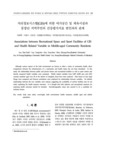

PARTNER
검증된 파트너 제휴사 자료
지리정보시스템(GIS)에 의한 여가공간 및 체육시설과 중장년 지역주민의 건강평가지표 변인과의 관계
방대한 850만건의 자료 중 주제별로 만들수 있는 최적의 산출물을 해피 캠퍼스에서 체험 하세요 전문가의 지식과 인사이트를 활용하여 쉽고 폭넓게 이해하고 적용할수 있는 기회를 놓치지 마세요
11 페이지
최초등록일 2015.03.25
최종저작일
2012.01

-
 * 본 문서는 배포용으로 복사 및 편집이 불가합니다.
* 본 문서는 배포용으로 복사 및 편집이 불가합니다.
미리보기
서지정보
· 발행기관 : 한국웰니스학회
· 수록지 정보 : 한국웰니스학회지 / 7권 / 1호
· 저자명 : 이대택, 이용수, 손윤선, 김명화, 이인영, 이승범
목차
Ⅰ. 서 론
Ⅱ. 연구방법
Ⅴ. 결 과
Ⅳ. 논 의
Ⅵ. 결 론
참고문헌초록
이 연구는 GIS 정보와 지역 자치단체의 자료를 이용하여 특정 도시지역의 여가공간 및 체육시설을 파악하고 이 정보들이 지역 주민을 대상으로 직접 측정한 건강관련 변인들과 어떠한 관계가 있는지를 살펴보는데 목적을 두었다. 선행연구들이 간접 데이터를 이용한 것과는 대조적이며 또한 우리나라에서 아직 시도되지 않은 도시환경과 건강과의 직접비교라는데 의미가 있다. 이 연구는건강에 영향을 미칠 수 있는 조성환경 요인과 공헌도를 평가하는데 주요한 방법적 도구들을 제시할 수 있을 것이다.영어초록
Although various aspects of the built environment are known to affect a status of community health, direct comparisons between the infrastructures of a community and health status has not been elucidated. In this study, the relationships between public and private leisure and recreational facilities as well as sport centers and directly measured health variables were examined. Health related variables from 5,497 (2,584 men and 2,913women) residents aged over 40 of the district of Gangbuk, Seoul have been analyzed. Data based on four legal Dongs were compared and Pearson correlations were employed for relationships between variables. No definite relationships between the two variables were noticed, suggesting the availability of activity facilities may be not solely explaining the health measure outcomes. It is thought that both objective and perceptional measures for analyzing health outcomes should be included. Sociodemographic status also seemed to be a candidate for inclusion factors.참고자료
· 없음태그
-
자료후기
-
자주묻는질문의 답변을 확인해 주세요

꼭 알아주세요
-
본 학술논문은 (주)학지사와 각 학회간에 저작권계약이 체결된 것으로 AgentSoft가 제공 하고 있습니다.
본 저작물을 불법적으로 이용시는 법적인 제재가 가해질 수 있습니다. -
해피캠퍼스는 구매자와 판매자 모두가 만족하는 서비스가 되도록 노력하고 있으며, 아래의 4가지 자료환불 조건을 꼭 확인해주시기 바랍니다.
파일오류 중복자료 저작권 없음 설명과 실제 내용 불일치 파일의 다운로드가 제대로 되지 않거나 파일형식에 맞는 프로그램으로 정상 작동하지 않는 경우 다른 자료와 70% 이상 내용이 일치하는 경우 (중복임을 확인할 수 있는 근거 필요함) 인터넷의 다른 사이트, 연구기관, 학교, 서적 등의 자료를 도용한 경우 자료의 설명과 실제 자료의 내용이 일치하지 않는 경우
“한국웰니스학회지”의 다른 논문도 확인해 보세요!
-
축제 환경단서와 문화관광형 전통시장 이미지 관계 연구 13 페이지
축제는 새로운 볼거리와 체험활동을 제공하여 관광객을 유치하고 관광객의 소비지출로 지역경제를활성화하는데 기여하고 있다. 이에 따라 문화관광부에서는 외래관광객 유치 확대 및 지역경제 활성화를 위하여 지역축제를 포함한 관광축제를 적극 지원 및 육성하고 있다(이용기, 이덕우, 이충기, 2003).이처럼 축제는 방문객을 성공적으로 유치하게 하는 지역의 문화적 자원(.. -
체육수업 내 라인댄스 적용에 대한 여자 고등학교 교사들의 인식 13 페이지
최근 라인댄스에 대한 선행연구들을 살펴보면, 라인댄스 참여를 통해 만족감, 사교성의 증대, 심리적행복감 증대, 스트레스 해소 등 전반적으로 라인댄스 통해 만족도가 높은 것으로 조사되었다(노은초, 2010;문행자, 2010; 박인실, 김영환, 2010; 송영순 등, 2011;체육수업 내 라인댄스 적용에 대한 여자 고등학교 교사들의 인식 285안명식, 2010.. -
골프퍼팅에서 점진적 연습방법의 효과 9 페이지
과제의 복잡성 또는 난이도는 그동안 맥락간섭을 이용한 연구들에서 그 효과를 검증한 연구들(예,Albert & Thon, 1998; Farrow & Maschette, 1997;Hebert, Landin, & Solmon, 1996; Landin &Hebert, 1997; Ollis, Button, & Fairweather, 2005;Tsutsui, Lee,.. -
골프지도자의 골프 교육과정을 통한 방향적 탐색 16 페이지
골프지도자들의 직업과 지도란 결국 지속적이며 진행 중인 교육과정 일부분으로서 이는 교육의 목표와 지도 실제라 할 수 있으며, 교육과정의 탐색은 골프지도자의 교육과정 및 방향적 탐색을알아보는 것임을 알 수 있다. 하지만 현재까지 체육학계 연구와 확보하고 있는 골프교육에 관한 자료는 한정되며, 부족한 실정이다. 따라서 이 연구의 주제인 골프지도자의 골프교육과정.. -
월경 전 여성 청소년들의 골밀도 특성 13 페이지
골밀도 특성에 관한 연구는 문헌에 많이 발표 되어 있으며, 이러한 특성에 영향을 미치는 여러가지 다양한 요인들에 대한 내용도 다방면의 연구를 통해 알려졌다. 유전과 잘못된 식습관, 칼슘과 마그네슘의 보충상태, 천식치료를 위한 albuterol의 복용 등은 골밀도의 매개 변수에 많은 영향을 미친다. 또한 골의 크기는 무게에 대한 골의 저항이 골의 지름의 크기..
문서 초안을 생성해주는 EasyAI
